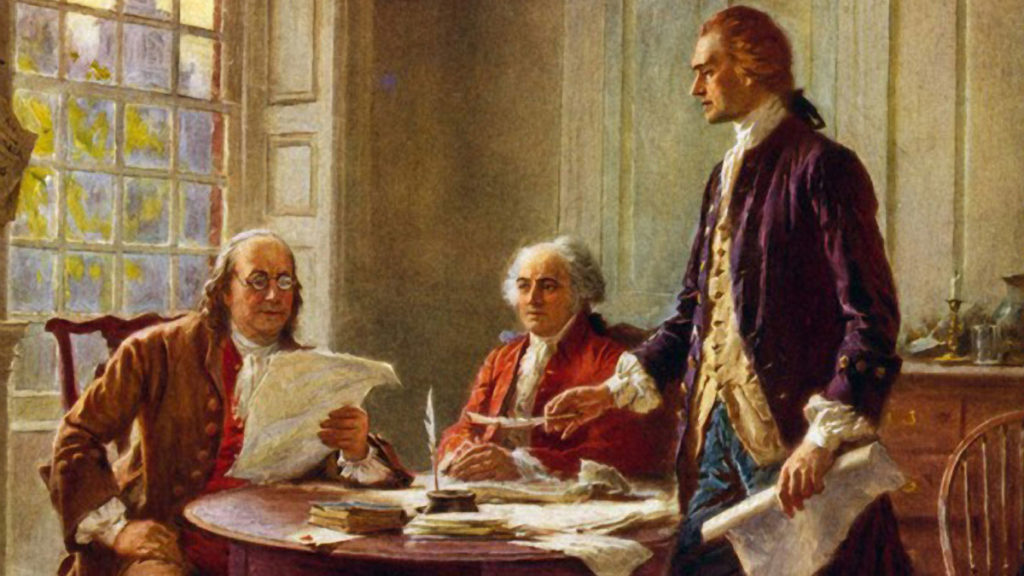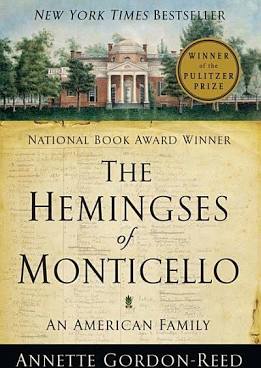For the past month or so, I feel like I have been living, on and off, with the Hemingses of Monticello, and their slave master, Thomas Jefferson, author of the Declaration of Independence and third President of the United States.
This is what a good book feels like sometimes, especially one that is biographical – and historical. While I read (listened!) to this 816-page book by Audible, it engrossed me for over 30 hours on and off over the past month. The author of The Hemingses of Monticello: An American Family, Annette Gordon-Reed, did such a fine job bringing in so much context. When I read history and biography, I absolutely love context. And yet, at times, even I almost thought she provided too much context, but it really brought this entire family’s experience to life in a way that seems almost impossible from the vantage point of two hundred years later. Gordon-Reed certainly did some amazing research, which she continually cites throughout the book.
We obviously know that Thomas Jefferson owned many slaves. However, I learned in this book that his childhood best friend was a black slave and that he inherited the vast majority of his own slaves from his father-in-law, John Wayles. At many times, with many different slaves, Jefferson also paid them wages. We know this because every time he paid them, he logged those payments in his very extensive personal records.
I also learned that Jefferson’s wife Martha was pregnant six times during their ten-year marriage; during and after each pregnancy she had extraordinary health problems. Only two of those six children lived past their childhoods. His wife died four months after she delivered their sixth child. It was heartbreaking to Jefferson, who apparently went into deep depression and even contemplated suicide. At Mrs. Jefferson’s bedside, while she was on her death bed, was a 10-year old slave, her half-sister, Sarah Hemings who also went by “Sally.”
You might ask: half-sister? Jefferson’s “white” father-in-law also had relations with one of his “half-black” slaves, Elizabeth Hemings, who produced several children with him and one of them was Sally Hemings, who was about three-quarters “white.” This makes Jefferson’s wife Martha the half-sister of Sally Hemings.
While his wife was still alive, Jefferson was asked to serve his country as a foreign ambassador in France. He declined because he did not want to leave his home in Virginia, including his wife and their children. But about two year after his wife passed, he was offered this opportunity again, and he took it. In some ways, it provided an outlet for him, an escape from the heartbreak of the passing of his wife. But this also meant he had to leave his two children, plus his many slaves, back in Virginia. They were looked after by friends who oversaw his family and his estate while he was gone. He was gone for five years – to live and serve his country in Paris. During that time, James Hemings (Sally’s brother) had come to Paris to serve as Jefferson’s “servant” and chef.
A few years later, he called on his youngest daughter to join him. The family members sent her half-sister, a slave, Sally Hemings, to chaperone her journey. They first stopped in London, where they stayed with John and Abigail Adams. Then they went on to Paris.

Both James and Sally Hemings had an extraordinary opportunity, as enslaved Americans, to visit and live in perhaps the most cosmopolitan city in the world at the time, Paris. James Hemings took culinary classes and became a master chef; on her way to France, Sally Hemings was inoculated against the smallpox epidemic sweeping much of the world. Jefferson ensured she (and his own daughter) received some of the best medical treatment available. This act – and the expense it must have caused him – gives a hint that Jefferson viewed Sally as more than a slave, but perhaps more like a member of the family.
It was in Paris as well where Jefferson later took up an intimate relationship with Sally Hemings, who was probably about 15 years old at the time. And, at this point, Jefferson was about 45 years old, thirty years older than Sally. Some might contemplate whether Sally, the half-sister of Jefferson’s late wife may have physically resembled Martha in some way, perhaps in a way that drew Jefferson to her physically.
The author spends a lot of time discussing whether we might classify his taking of Sally Hemings as some kind of “rape,” but she concludes that there is no evidence of that. She also details the very different power men had over women (including in marriage, including those of the same race) at that time and what were the cultural expectations of the time. And at a time when Sally could have perhaps sought her freedom from slavery in France, she did not. Just months before the horrors of the French Revolution began, she decided to go back to Virginia with Jefferson, where she lived as his unmarried lover for the rest of his long life. Jefferson fathered seven children with Sally.

This book really shows us that slavery and relations between whites, blacks, and those who blended the color lines, as well as between men and women, were much different and very much more complicated than we might simplify from our historical vantage point today. But one thing I think that the author really points out is that, unlike the Hemingses, so many slaves are left anonymous to historians.
One of the reasons the Hemingses have drawn the fascination of historians and modern readers alike is that they have a history – mostly because their history was recorded by their very famous master, Thomas Jefferson. As she says: “There is power in a name. And as heart-wrenching as slavery was, what may be worse is the anonymity of so many slaves, names which we will never know.”
She also demonstrates that Jefferson’s slaves were loyal to him, including when the British came to his residence in an attempt to arrest him during the American Revolution, as he was the crafter of the Declaration of Independence and was serving as the revolutionary governor of Virginia. However, they wanted their freedom too. He later gave James Hemings his freedom. Once he became President, he called on James Hemings to try to hire him as his chef at the White House. Hemings refused. This baffled Jefferson and perhaps hurt him. Within a year, James Hemings, who was living alone at the time, committed suicide. Freedom was not always an easy thing for many free blacks.
Over the course of the rest of his life, Jefferson kept his relationship with Sally – and the seven children she had with him – quiet from the public view, but most people near Monticello were aware of this relationship. When he later ran for President in 1800, and again in 1804, there were smear campaigns against him (especially in 1804) that brought this relationship with his slave to the national spotlight. It did not seem to affect his ability to get elected and re-elected.
Jefferson fought very much, in his writings, pronouncements, and personal beliefs, that slavery should eventually end in America. He did not like it and was ashamed that it was a part of the American experience – it remained a dilemma for a man who owned so many slaves. He did grant a few of his slaves (including some of the Hemingses) their freedom while he was alive, and he freed some in his will, but most remained enslaved while he was alive and after he passed.

When Jefferson died, he had a lot of debts and this affected everyone at Monticello, including his white family members, his half-white children, his concubine Sally Hemings (who was 53 years old when the 83-year old Jefferson passed), and all of his black slaves, some of whom were later sold off on auction blocks. This American family was deeply disrupted at his passing, mostly because of his debts and because he could never get in position to have the financial capacity to free them. And he wasn’t quite sure if freedom was indeed the best thing for them, with many of them, like Sally, who were approaching old age.
Jefferson was a flawed human being, as we all are. The human experience is a complicated one. The ideals of equality and freedom he held continued to flow through the next two hundred years throughout American history. And his family and its descendants represent the various experiences that blacks, whites, and those of mixed ancestry have had in this grand American experiment. While Jefferson’s name has allowed us to know the Hemingses – to the extent possible that we can know them – it makes you wonder about all the other human beings in American history we shall never know – both white and black – because they were not important enough to be remembered by history. There is simply not enough data available to know them. But for 30 hours, I feel like I got to know the Hemingses and the Jeffersons and break into their world and the kind of complicated experience their lives truly were.

